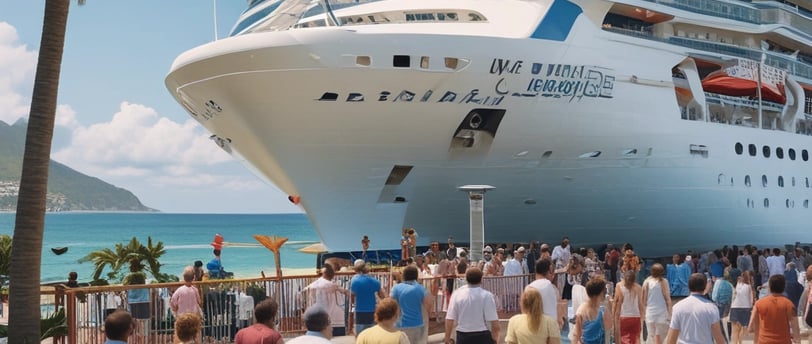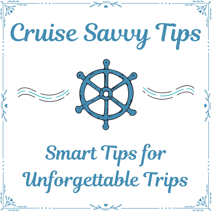Cruise Lingo 101: Terms Every First-Time Cruiser Should Know
If you’re new to cruising, you might find yourself surrounded by words and phrases that sound completely foreign. What’s a muster drill? Why is everyone talking about their stateroom instead of their room? And what exactly is a lido deck? Don’t worry! Cruise lingo isn’t as complicated as it seems. By the end of this post, you’ll be speaking like a seasoned cruiser and feeling confident when you step on board. Let’s break down some of the most common cruise terms every first-time cruiser should know.
FIRST TIME CRUISER
Terisa Kay
3/8/20254 min read


1. Ship vs. Boat
Let’s get one thing straight right away—never call a cruise ship a “boat.” A ship is a large vessel that can carry passengers or cargo over long distances. A boat is usually smaller and used for shorter trips. If you call a cruise ship a boat, expect a few seasoned cruisers to correct you!
2. Stateroom (or Cabin)
This is your room on the cruise ship. Some cabins have balconies, while others are inside cabins (no windows) or oceanview cabins (with a porthole or window but no balcony).
3. Muster Drill
This is one of the most important parts of your cruise experience. The muster drill is a mandatory safety briefing that all passengers must attend before the ship sets sail. It’s similar to an airline’s safety demonstration but happens at designated locations called muster stations.
4. Embarkation & Debarkation
Embarkation – The process of boarding the ship at the beginning of your cruise.
Debarkation – The process of getting off the ship at the end of your cruise.
Both can be busy times, so be prepared for lines and security checks.
5. Lido Deck
This is the deck where you’ll find the pool, hot tubs, and usually a buffet or casual dining spots. It’s a prime hangout area for many cruisers. Don't forget your sunblock!
6. Tender vs. Dock
Depending on the port, your ship will either dock at a pier or use tenders (small boats) to transport passengers from the ship to the shore. If your itinerary has a tender port, you’ll need to take a small boat to get to land.
7. Port & Starboard
Instead of saying "left" and "right," ships use nautical terms:
Port – The left side of the ship when facing forward.
Starboard – The right side of the ship when facing forward.
A handy trick to remember: "Port" and "left" both have four letters!
8. Forward, Midship, and Aft
These terms describe different areas of the ship:
Forward – The front of the ship.
Midship – The middle of the ship (often the most stable area).
Aft – The back of the ship.
Your cabin location can make a big difference in your cruise experience, so pay attention when booking!
9. Gangway
The walkway that connects the ship to the port when you’re getting on and off. It’s where you’ll go through security when returning from excursions.
10. Sea Day vs. Port Day
Sea Day – A day when the ship does not stop at any port and sails the open ocean.
Port Day – A day when the ship docks at a destination, allowing passengers to explore on land.
Some people love sea days for relaxation, while others prefer port days for adventure!
11. Shore Excursion
An activity or tour you take while at a port destination. Shore excursions can be booked through the cruise line or independently. Options range from sightseeing tours to adventure activities like zip-lining or snorkeling.
12. Cruise Card (Sail & Sign Card, SeaPass, Key to the World Card, etc.)
Your cruise card is your room key, onboard charge card, and ID all in one. Cruise ships are cashless, so this card is how you’ll pay for drinks, souvenirs, and specialty dining.
13. Open Seating vs. Traditional Dining
Traditional Dining – You have a set dining time and table each night. You will have the same wait staff every night, this is a plus if you have a special diet. They get to know you and will help you with the menu!
Open Seating (or My Time Dining, Freestyle Dining, etc.) – You can eat at different times and tables each night.
Each cruise line has its own system, so check your options when booking!
14. Specialty Dining
Most cruise ships offer complimentary dining in the buffet and main dining rooms, but they also have specialty restaurants that require an extra fee. These can include steakhouses, sushi bars, and high-end Italian restaurants.
15. Drink Package
A prepaid package that covers soda, specialty coffees, or alcoholic drinks (depending on the package). These can be a good deal if you plan to drink a lot, but make sure to check the price before purchasing!
16. Cruise Critic & Roll Call
Cruise Critic – Another website with reviews and forums for cruise lovers.
Roll Call – A group of passengers who connect before the cruise to share tips and plan meetups.
Joining a Roll Call is a great way to make friends before you even step on board!
17. Disembarkation Tags & Luggage Pick-Up
On the last night of your cruise, you’ll receive luggage tags with a designated group number. If you choose "checked luggage", crew members will take your bags the night before and you’ll pick them up in the cruise terminal the next morning. If you choose self-disembarkation, you’ll carry off your luggage yourself.
18. Cruise Director
The person in charge of onboard entertainment and activities. They host trivia, parties, and shows, making sure everyone has a great time.
19. Motion Sickness Bands & The Patch
If you’re worried about getting seasick, you’ll hear about these remedies:
Motion Sickness Bands – Wearable wristbands that use acupressure to reduce nausea.
The Patch – A small behind-the-ear patch (Scopolamine) that helps prevent seasickness.
Meclizine - My personal favorite. A 24-hour dissolvable tablet.
Many first-time cruisers bring these just in case!
20. Ship Time vs. Local Time
Some ships stay on their departure port’s time zone (ship time), while others adjust to each new port’s local time. Always double-check the time before heading out on an excursion—you don’t want to miss the ship!
Final Thoughts
Learning cruise lingo might feel overwhelming at first, but once you’re on board, it all starts to make sense. Understanding these terms will help you navigate your first cruise like a pro, so you can focus on relaxing, exploring, and having fun! 🚢💙
Support
Essential tips for first-time cruise travelers.
info@cruisesavvytips.com
© 2025. All rights reserved.
Subscribe to our weekly newsletter and be the first to discover our Featured Product of the Week—plus enjoy an exclusive 20% off! Don’t miss out on special deals, cruise tips, and more!
